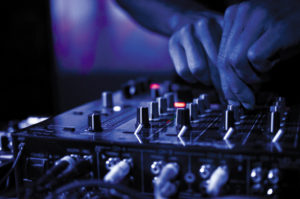Perhaps the least understood, listened to and least admired type of music is electronic music. What is electronic music? You ask. The Harvard Dictionary of Music defines electronic music as music made by producing, magnifying and recording sound, then reproducing it by electro-acoustical means. In other words, electronic music is made up of sounds created exclusively by electronic implements rather than traditional instruments. It includes electronic instruments, synthesizers and recording equipment.
“In 1955, David Sarnoff, chairman of the National Broadcasting Company (NBC) and Radio Corporation of America (RCA), unveiled the Electronic Music Synthesizer, that was intended to mimic sounds of all musical instruments,” wrote Alex Ross, in his book The Rest is Noise.
 The Moog Synthesizer, an electronic instrument of great versatility and complexity, translates the composer’s desires into actual sound. It creates and manipulates sounds. This machine was probably the most famous of the early electronic instruments. It was marketed from 1965 on. The Mini-Moog, a relatively affordable and widely available instrument, was released to the public in 1970.
The Moog Synthesizer, an electronic instrument of great versatility and complexity, translates the composer’s desires into actual sound. It creates and manipulates sounds. This machine was probably the most famous of the early electronic instruments. It was marketed from 1965 on. The Mini-Moog, a relatively affordable and widely available instrument, was released to the public in 1970.
The forerunner of electronic music was Musique Concrete. Much of the research and development of this form of music was done after World War II, in the 1940s and 50s. In Paris, Pierre Schaeffer and Pierre Henri were using magnetic tape to record many different sounds that were either non-musical or musical. They experimented with different speeds and even tried playing them backwards. They cut and edited the sound to create what they termed Musique Concrete. It consists of electronically modified natural sounds or sounds that already exist in nature.
Around the middle 20th Century, electronic studios first began in Europe and later in the United States. Musique Concrete was started in the studio of the French Radio in Paris. Concurrently, composers in the Cologne studio in Germany were also experimenting in much the same way. The idea was to make pure electronic music.
A leading exponent of this movement was Edgar Varese (1883-1965, a Franco-American composer, who lived in Greenwich Village, New York. Keen interest in electronic instruments attracted many composers. Electronic instruments included electric organ, piano and guitar. As early as the 1890s, there were experimental electronic instruments in Russia and France. In this early period of development, music was recorded on tape for later exposure and performance. Studios were being established all over the world.
 In America, studios at Columbia University, University of Illinois, Stanford and Princeton were pioneers in this new field of technology. There were many others but these were prominent. The people that worked in these studios were termed “composer-engineer performers.”
In America, studios at Columbia University, University of Illinois, Stanford and Princeton were pioneers in this new field of technology. There were many others but these were prominent. The people that worked in these studios were termed “composer-engineer performers.”
Composers of Electronic Music
John Cage (1912-1992), a Los Angeles native, was considered the most radical American composer in this genre. In the 1950s he was involved with “tape music” that was the mixing of both traditional and electronic music. Most assuredly, Cage used as an instrument any object capable of producing sound. Apparently no other composer came close to using such disparate objects. He used junk for instruments, like automobile brake drums, anvils and vacuum cleaners. He was more interested in rhythm than melody.
Cage wrote for a strange combination of instruments. His Imaginary Landscapes No. 4, was written in 1951. He manipulated the frequency and volume controls on 12 radio sets. The resulting sound varied according to the programs on the air at that time. Cage was more interested in a dissonant style, rather than consonant music. He also composed a number of pieces for percussion ensemble.
About his music, Cage said, “I am going toward violence; rather than tenderness; Hell rather than Heaven; ugly rather than beautiful; impure rather than pure. Because by doing these things they become transformed and we become transformed.” Cage’s writing reveals a glimpse into his character and personality. As early as 1949, Cage encountered several European pioneering technicians of electronic music, who set in motion a campaign against music of the past.
Karlheinz Stockhausen (1928-2007) was born in a village outside of Cologne, Germany. His musical training was conventional at the Musikhoch Schule and the university in that city. During World War II, Stockhausen became interested in opening his ears to new and somewhat strange sounds. He listened to American military band broadcasts and was intrigued by the jazzy rhythms of the Glenn Miller Band. Stockhausen was also moved by the melodies and overall feel and excitement of jazz.
The new art of electronic music intrigued Stockhausen from the beginning. “In 1955 and 56 he created, Gesang der Junglinge or, Song of Youth, his most original electronic creation and perhaps the most influential electronic piece ever composed,” wrote Alex Ross. In 1960 he completed Kontakte, where live and electronic sounds bounce off each other or blur together. In 1962 a monumental work was conceived called, Momente. Ross wrote, “This work involved four choirs, soloists trumpets and trombones, a pair of electric organs, a large percussion battery and a Japanese Tam-Tam, (gong).” It was described as the Bacchanalia of the avant garde; a shouting, clapping, stamping liberation of the senses.”
Stockhausen created a two-hour long electronic-instrumental fantasy called Hymnen, in 1966-67, based on some of the world’s national anthems.
Early experimenters in electronic music thought of expanding, not replacing traditional genres. Today a divide exists between traditional and electronic music practitioners. A better understanding can be achieved by including the study of contemporary music with electronic music.
Today, computer technology and music software has made it possible to create new electronic music with devices commercially available for home use.
Many people, including myself, have not embraced and tried to understand fully, electronic music. It is certainly not my favorite. Perhaps we should open our minds and ears and try a little harder to be receptive to new ideas and new sounds.
Please submit your questions and comments to banddirector01@comcast.net Visit our website at www.danvilleband.org for up-to-date information about the Danville Community Band.
Leave a Reply